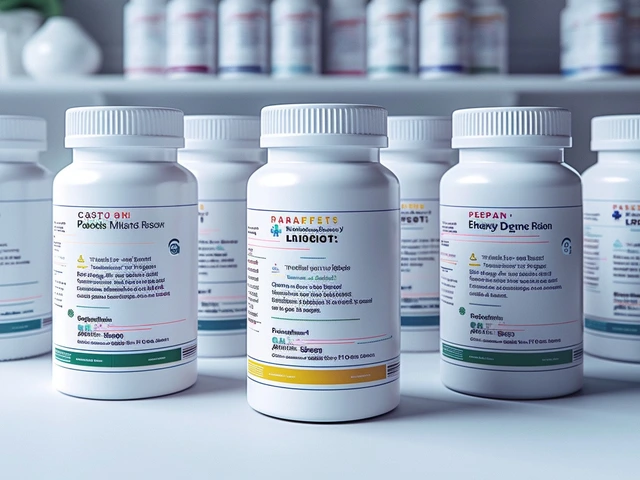
Meet the Power-Packed Echinacea: The Tiny Flower with Mighty Benefits
As I begin this write-up, my faithful golden retriever, Daisy, is curled up by my feet, and my spirited green-cheeked conure, Kiwi, is perched on my shoulder. They are a testament to how we all have our own ways of staying healthy – Daisy with her daily romps in the park and Kiwi with his balanced diet of seeds, fruits, and veggies. And me? I rely on Echinacea. A fabulous dietary supplement that's currently the buzzword in health circles worldwide.
Now, some of you might be scratching your head thinking, 'What on earth is Echinacea?' Well, fear not. Think of me as your guide today as we venture into the world of this remarkable herb. We'll touch upon its history, learn about its health benefits, unravel the scientific evidence supporting its use and, finally, understand how to incorporate it into our everyday routines.
Unfolding the History of Echinacea
Interestingly, long before Echinacea became the trendsetter, it was a staple in Native American traditional medicine. The Great Plains Indian tribes were known to use it for treating a wide range of ailments, from snake bites to infections. It wasn't until the late 19th century that Echinacea was introduced to the Western world by traditional doctors. Fast forward to today, this flower-powered supplement is being hailed as an immune booster and the perfect ally in your health journey.
Fascinating, isn't it? When you're taking your next dose of Echinacea, pause for a moment, and pay homage to its rich history. This tiny herb has survived and thrived through ages, and now it's ready to power our wellness regime.
Identifying the Powerhouse of Immunity: Echinacea Species
Let's delve a bit into botany now. The Echinacea family comprises nine species, out of which Echinacea purpurea, Echinacea angustifolia, and Echinacea pallida are the most widely recognized and used for their medicinal qualities. Named after the Greek word 'echinos,' meaning hedgehog, the Echinacea flower is recognized by its spiky central disk. Its vibrant petals dance with the breeze, and while your eyes feast on its beauty, its potent properties are continually working to ward off health challenges.
Decoding the Health Benefits of Echinacea
The health benefits of Echinacea are as colorful as the flower itself. One might even say, health blooms with the regular intake of this potent supplement. Let's decode these benefits, one petal at a time.
First and foremost, Echinacea is seen as an immune system revatilizer. It increases the body's production of white blood cells, our principal guardians, equipping us with a stronger defense against infections and diseases. Given the current times, when our overall health is of pivotal importance, incorporating Echinacea into our diet can be of immense help.
Did you know Echinacea is also lauded for its anti-inflammatory properties? Inflammation is the body's natural response to pathogens, damaged cells, and irritants. Prolonged inflammation, however, could lead to chronic conditions like heart disease or stroke. My Kiwi, for example, had a minor inflammation once and trust me, it was no bird (walk) in the park. Echinacea, with its anti-inflammatory properties, steps in just at the right time to save the day.
Supporting the Talk with Science: Evidence that Backs Echinacea
Here comes the critical part: as enticing as the benefits of Echinacea might sound, what does science say about it? Thankfully, researchers and health experts worldwide echo similar sentiments about the efficacy of Echinacea – it's a genuine gift from nature.
Several scientific studies and clinical trials have proven Echinacea's role in strengthening the immune system, reducing the symptoms and duration of the common cold, and speeding up recovery. Of course, it's not an end-all cure. However, it does tip the scales in favor of better health.
Adding Echinacea to your Everyday Routine: Simple yet Effective Ways
I know what you're thinking – 'That sounds fantastic, Caspian. But how do I add Echinacea to my everyday routine? And how much should we consume?' Glad you asked.
Echinacea takes several forms: tablets, capsules, tinctures, extracts, tea, and even juices. Whichever form you choose, the key is consistency. Start with small doses and observe how your body responds before gradually increasing the dosage.
Small Warning Bells: Precautions and Side-Effects of Echinacea
While the wonders of Echinacea are many, it's essential to understand that everyone is not suited for its consumption. People with autoimmune diseases, pregnant women, children, and those allergic to plants in the daisy family should consult a healthcare provider before starting with Echinacea. Remember, health is a personal journey, and what works for some might not work for all.
The Key to Health: The Final Take on Echinacea
All said and done, it is quite a marvel how Mother Nature always has remedies for us – in the form of a humble herb, a tiny berry, a leaf, or a beautiful flower like Echinacea. Health, as I always say, is not a destination but a journey, and adding Echinacea to your diet might be your next great step in this journey.
So, here's to making Echinacea the superhero of our dietary regime and ushering in a future where we're equipped with a strong immune system, ready to conquer whatever comes our way. And now, I believe Kiwi is ready for his walk. Until next time, folks, stay healthy and keep blossoming!







11 Comments
Echincea can boost immunity, but you gotta watch the dosage.
The phytochemical synergy inherent in Echinacea purpurea constitutes a paradigmatic exemplar of immunomodulatory efficacy. From a mechanistic standpoint, the alkamide profile orchestrates leukocyte activation via NF-κB pathway modulation. Such bioactive matrices render the herb a non‑pharmaceutical adjunct in prophylactic regimens. Moreover, the evidence hierarchy mandates a meta‑analytic scrutiny to substantiate clinical claims. Consequently, one must eschew layperson anecdotes and adhere to empirically validated protocols.
Guys this is the real deal 🇺🇸💪 Echinacea is like the patriotic shield for our bodies! No more lazy colds, we fight them like we fight anything else. Get it now or suffer the weak‑link fate!!! 😤🔥
Love the vibe here we all want to feel good keep it simple and stay consistent. Try a daily capsule and see the difference. Your body will thank you
One must ponder the ontological implications of relying on botanical tinctures – are we truly mastering our health or merely surrendering to nature’s whim? The discourse often neglects the epistemic humility required when integrating phyto‑therapy into modern regimens 🙂 Yet the empirical data cannot be dismissed outright, it offers a mosaic of possibilities 🌿 The balance lies in discerning prudence from blind faith. Ultimately, the pursuit of wellness is a dialectic, an ever‑evolving conversation between body and herb 🤔
While the enthusiasm is noted the actual impact remains marginal. The supplement appears overhyped.
Echinacea has been heralded across centuries as a botanical panacea. Its roots trace back to indigenous practices where healers fashioned poultices for wounds. The colonial transference introduced the plant to European apothecaries. In the twentieth century scholars embarked on clinical trials to quantify efficacy. Results have been mixed but some studies highlight reduced cold duration. Critics argue sample sizes were insufficient. Proponents counter with meta‑analyses demonstrating modest benefits. The active constituents include cichoric acid and polysaccharides. These molecules interact with immune cells enhancing phagocytosis. Moreover the herb exhibits anti‑inflammatory properties via cytokine modulation. Patients often report subjective improvements in vitality. Yet dosage standardization remains a challenge across manufacturers. The regulatory landscape varies globally affecting product consistency. Consumers should scrutinize labels for species identification. Ultimately the decision to incorporate Echinacea rests on personal health goals and informed consultation.
Echinacea isn’t a miracle cure.
I get where you’re coming from i think it can still help some people 🙂 but it’s important to check for allergies first.
Oh, please, another fervent proclamation about a flower that “miraculously” bolsters our defenses, as if we’ve never heard such hyperbole before. The scientific community has, of course, meticulously dissected every facet of Echinacea’s pharmacodynamics, leaving no stone unturned, which, of course, translates to flawless real‑world outcomes for every individual. Yet we are told to gulp down capsules with the same blind faith we reserve for celebrity endorsements. It’s truly astounding how quickly nuanced data is reduced to a simplistic “take two daily and feel invincible” mantra. One might argue that the very notion of a universal immune booster is absurd, given the complex interplay of genetics, environment, and lifestyle. Nonetheless, the market thrives on this reductionist narrative, feeding on the anxieties of the health‑conscious masses. So, kudos to the hype machine, but let’s not abandon critical thinking at the altar of trending supplements.
While I respect the concerns raised, it is worth noting that numerous peer‑reviewed studies have documented modest reductions in cold duration when Echinacea is administered early in the symptomatic phase. Healthcare professionals often recommend it as an adjunct rather than a standalone remedy, emphasizing proper dosing and product quality. Patients should consult their physicians to determine suitability, especially if comorbidities or medication interactions are present. Ultimately, an evidence‑based approach, balanced with individual health considerations, remains the prudent path forward.